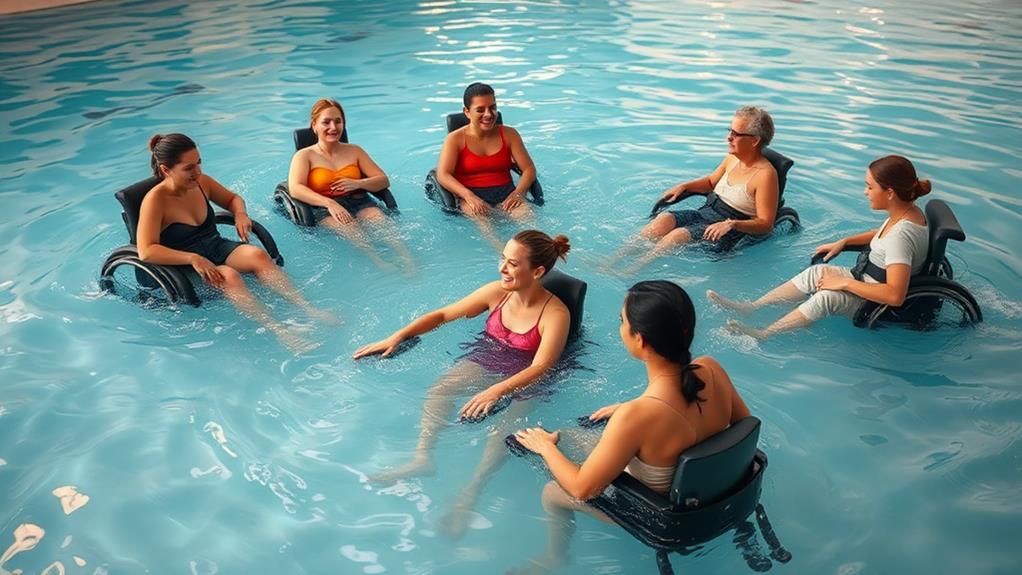When you consider water therapy, you might think of its soothing effects on sore muscles and joints. It can considerably enhance your circulation and even lift your mood, making it an appealing option for recovery. However, before you jump in, there are important factors to keep in mind, including potential risks and how it fits into your overall treatment plan. Understanding these nuances can make all the difference in your experience, so let's explore what you should know before taking that first step into the water.
Overview of Water Therapy

Exploring water therapy, or hydrotherapy, reveals its potential to enhance well-being through the therapeutic use of water. You might be surprised to learn that this method uses water in various ways, like baths, saunas, and aquatic exercises, to help with healing and symptom relief.
It's especially good for those dealing with conditions like osteoarthritis and fibromyalgia. The buoyancy of water makes you feel lighter, which is fantastic for anyone with joint pain or limited mobility. Imagine doing exercises without that heavy weight on your joints; it's like floating in a cloud!
Plus, warm water therapy is a cozy way to relax your muscles, ease tension, and improve blood circulation. This comfy environment isn't just soothing; it's also a great support for rehabilitation.
However, remember that while hydrotherapy can help relieve symptoms, it's not a cure-all. Always chat with a healthcare professional first, just to be sure it's safe for you.
Key Benefits of Water Therapy
Water therapy offers a range of benefits that can greatly improve your quality of life. If you're dealing with injury or illness, this therapy can be a game changer. The warm water helps relax your muscles, making it easier to move without pain.
Plus, the buoyancy of water reduces stress on your joints, which is perfect if you have limited mobility.
One of the awesome benefits of water therapy is that it can help with weight loss. Since water provides natural resistance, you can strengthen your muscles without straining them too much. It's like having your own personal trainer, but much more fun!
Not only does aqua therapy boost your strength and mobility, but it also lifts your mood. Imagine floating in warm water while your stress melts away—it's bliss!
Regular sessions can even improve your balance and coordination, especially for older adults, lowering the risk of falls.
Important Considerations

Before diving into water therapy, it's vital to consult with a healthcare provider. They can help determine if this type of therapy can help you based on your individual health risks. Remember, while water therapy has its benefits, it isn't a magical cure for underlying conditions. Instead, think of it as a way to alleviate symptoms and improve your overall well-being.
You should also be aware of the physical properties of water and how they can impact your safety. Slips, burns, frostbite, and infections are potential risks during treatment, so following proper precautions is important. Always listen to your body and pay attention to any discomfort.
Also, be cautious of claims that water therapy can detoxify your body or cure diseases. Many of these statements are unproven and misleading. Good medical advice emphasizes that water therapy is a complementary treatment, not a replacement for other therapies or medications.
Popular Techniques and Practices
Numerous techniques can enhance your experience with water therapy, catering to various needs and preferences. One popular method is warm water therapy, where you soak in heated water that helps relax your muscles and improve circulation. This can be especially useful if you're dealing with conditions like arthritis or fibromyalgia.
Aquatic therapy is another great option. In a warm-water pool, you can perform controlled movements that promote recovery while putting less stress on your joints. Plus, the properties of water provide natural resistance, making water-based exercise perfect for strengthening muscles without heavy weights. This is fantastic for anyone looking to treat a variety of issues or help you lose weight.
Don't forget about Epsom salt baths—they're a great way to unwind! For recovery after exercise, cold water immersion can do wonders, too.
If you're looking for a social aspect, consider joining group aquatic therapy sessions. Therapy can be helpful not just for your body but also for your spirit, creating connections with others on the same journey.
Accessibility and Resources

While many people can benefit from water therapy, access to these resources can vary considerably depending on where you live. If you're in a big city, you might find several facilities offering pool therapy. However, if you're in a rural area, you may need to travel a bit to find the right place.
Many hospitals and clinics provide aquatic therapy, but not every institution has the necessary pools. This can sometimes make things tricky for patients.
If you're looking for private healthcare options, make certain those facilities have qualified practitioners. You want to guarantee you're getting the best care possible!
Don't forget to check out local arthritis support groups or community centers as well. They often provide additional resources or even classes for aquatic therapy, making it easier for you to join in.
If getting to a facility feels overwhelming, consider home hydrotherapy. Using your bathtub or even an inflatable pool can be a fun way to practice therapy at home.
This way, you can enjoy the benefits of water therapy whenever you want, without needing to leave your cozy space!




